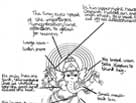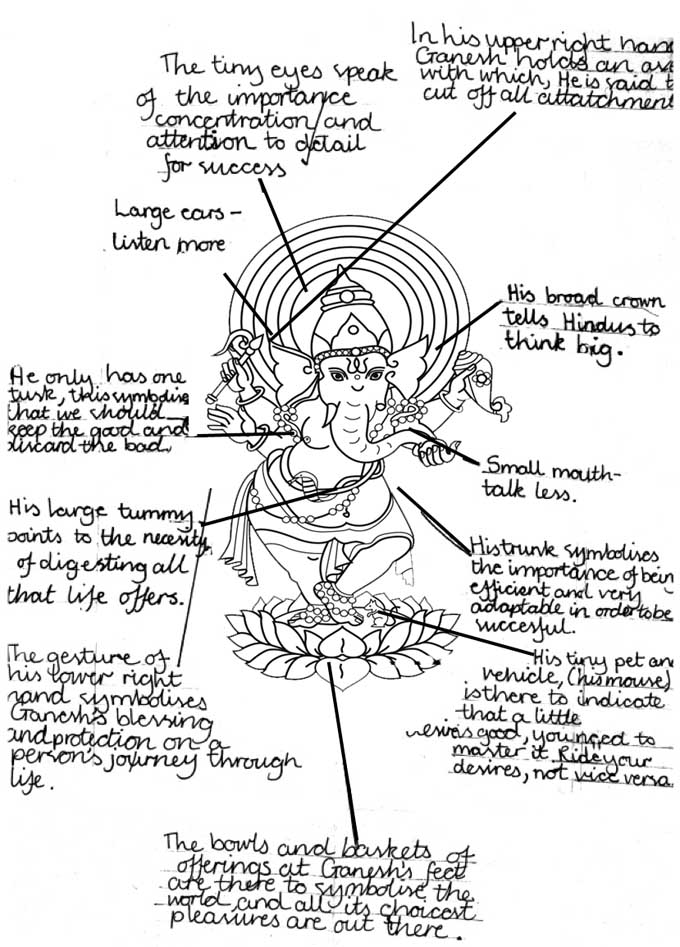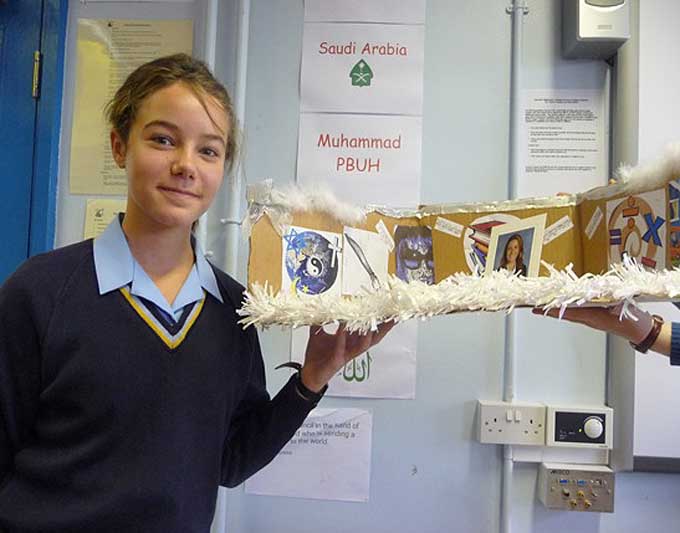Exemplification for foundation subjects
Religious education exemplification standards file level 5
Pupil's profile
Pupil C has a good natural aptitude for religious education and can compare and contrast features of religion at a high level. She enjoys working in a team and her comments and ideas help other pupils formulate their own opinions. She finds peer and self-assessment useful and is always keen to help others improve.
Evidence groups
What questions can I ask about Hindu worship?
Context
These activities were part of a unit that was the first exploration of Hindu worship for most pupils in the class. Pupils began by looking at a variety of photographs depicting scenes of Hindu worship. Working in groups, pupils chose one photograph to study in detail. They recorded their observations and used the 'community of enquiry method' to identify the best question raised by their observations. They focused on that question and explained what they had learnt about Hindu worship from the photograph.
Pupils then moved on to explore the different ways Hindus may express their belief in God. They considered a number of deities including Ganesha, Shiva and Krishna. Using a variety of sources, including stories and their own understanding of symbolism, they suggested meanings for symbols in a picture of Ganesha.
Pupil's work
Questions about Hindu worship
Next steps
To progress, Pupil C needs to:
use religious and philosophical terminology and evidence more effectively to support her explanations
incorporate some religious terminology and concepts into a more detailed explanation of the beliefs underpinning a variety of Hindu practice. Concepts may be specific to Hinduism, such as puja or moksha, or more generally related to religion and belief, for example devotion
explain the reasons for diversity within and between religions, for example explain why many Hindus would say the murti itself is not greater than them but its role is very important in providing a link to God
express insights of her own about questions such as 'How can murtis help Hindus express their beliefs?'
test her own ideas and assumptions against those of others using a range of sources, including other pupils in her class.
How might worshipping Ganesha affect the life of a Hindu?
Context
This activity was part of a unit exploring Hindu worship. This activity developed from the questions identified in the first activity. Pupils were asked to identify the questions that would allow them to learn the most about religion and then focus on considering those questions.
Pupil C carried out her own research using a range of sources. She then considered the challenges people face in their daily lives and imagined how worshipping Ganesha might support a Hindu in some of these situations.
Pupil's work
Assessment Commentary
Pupil C has shown that her understanding of Hinduism and of the impact of Hindu forms of worship has developed during her study of Hinduism. By making the link between issues raised by Hinduism and her own life she has been able to provide an answer to one of her own initial questions.
Thinking about religion and belief:
Pupil C has explained the connection between belief in God and the practice of worshipping through murtis. She has also explained the impact of that belief on the lives of individual Hindus: 'I think that when a Hindu worships a certain murti for a certain reason, they truly believe this god will help them…after worshipping a god they feel stronger, mentally, physically and emotionally.'
Enquiring, investigating and interpreting:
Pupil C has suggested several answers to the key question that studying Hinduism raised for her - how might worshipping a deity such as Ganesh affect the life of a Hindu. For example she has written 'If they are having a bad time at school, they may worship a murti of Ganesha because he is the god of knowledge… .' She has used relevant sources and evidence to support her answer: 'A Hindu may worship Ganesh because they are facing an obstacle. This obstacle could be anything, maybe a problem at school or work'. She has used her learning about the traditional role of Ganesh in Hinduism as 'the remover of obstacles' as evidence to illustrate her point.
Reflecting, evaluating and communicating:
Pupil C has recognised that issues and questions raised by Hindus are relevant to her own life. For example where she has written '…the features on his face represent certain qualities that someone may need to help them in school. (i.e. large ears and small mouth - listen more talk less.)' She has also expressed a clear view about how a source of inspiration such as Ganesh makes a difference to someone's beliefs: 'The symbolism means that if one walks on a path set by Ganesh, success and prosperity will always be close. The worshipper may remember this and pray to Ganesh.' This evidence complements the evidence found in piece five, which demonstrates the pupil's ability to discuss sources of inspiration in relation to her own beliefs.
Next steps
To progress, Pupil C needs to:
incorporate some religious concepts into a more detailed explanation of Hindu beliefs. Concepts may be specific to Hinduism, such as karma or Brahman, or more generally related to religion and belief, for example inspiration.
Why are cows held to be sacred in Hinduism?
Context
This activity was part of a unit exploring Hindu worship. After learning about reincarnation (samsara), karma, dharma and ahisma, pupils explored why cows are sacred in Hinduism. They discussed the case of Shambo the bull who lived at the Skanda Vale Temple and was to be put down after contracting bovine tuberculosis. A group of people, including some Hindus, ran a campaign to keep the bull alive. Pupils formulated their own questions about the case that reflected Hindu belief and practice and carried out research into the importance of cows in Hinduism to answer their questions. They also discovered why there was such a range of views about this case.
Pupil's work
_medium_tcm8-17431.jpg)
Why are cows held to be sacred in Hinduism? (page 1)
When carrying out the research Pupil C found some of her own sources and developed her own questions.
_medium_tcm8-17432.jpg)
Why are cows held to be sacred in Hinduism? (page 2)
When carrying out the research Pupil C found some of her own sources and developed her own questions.
_medium_tcm8-17433.jpg)
Why are cows held to be sacred in Hinduism? (page 3)
When carrying out the research Pupil C found some of her own sources and developed her own questions.
Assessment commentary
Pupil C used what she had learnt in other lessons and her research skills to explore this contemporary issue. She was motivated by this activity, which she found genuinely interesting, and carried out her own research into the influence of religion and belief on the case.
Thinking about religion and belief:
Pupil C understood the contemporary issue of Shambo the Bull and discussed it with reference to Hindu beliefs about the importance of cows in Hinduism. She has used concepts of sacredness and respect for life which connect to a wider issue (ultimate question) about harmlessness and the sanctity of life. She has written: 'cows are sacred to Hindus because when Krishna grew up he was a cowherd. They are his favourite animals.' She has explained connections between the question of whether or not cows should be protected and the belief that they are sacred according to Hindu scriptures.
She has also explained how and why differences in belief may be expressed within Hinduism. For example in her answer to question 1 she has written 'A lot of Hindus do not get involved because they do not believe cows are special or important.'
Enquiring, investigating and interpreting:
Pupil C has suggested answers to a series of questions on the relationship between Hindu belief and the case of Shambo the Bull. She did some independent research although her teacher guided her to the appropriate sources so she could answer the questions fully.
In her answer to question 3, her explanation has recognised and explained diversity in the way that beliefs may be expressed: 'A lot of Hindus do not get involved because Hinduism is a varied religion. Some are vegetarian because they believe killing animals is murder, others aren't.'
Next steps
To progress, Pupil C needs to:
appreciate further the reasons for diversity within and between religions
incorporate more religious concepts into her explanations
set out her own lines of enquiry into aspects of religions and beliefs with less guidance from the teacher.
How do sources of inspiration make a difference?
Context
This activity was part of a unit exploring Hindu worship. Following lessons on Hindu worship, the role of shrines and the way Hindus live, pupils created a collection of inspirational and significant objects to describe their inspirations and role models. Each pupil gave an oral presentation to explain how their shrine might affect their behaviour. Some pupils compared their 'shrine' with a Hindu shrine.
Pupil's work
Assessment commentary
Pupil C has produced an attractive collection of inspirational and significant objects that shows she understands one interpretation of the concept of a shrine - a place of devotion or commemoration. She has written extensively about her sister as a source of inspiration.
Reflecting, evaluating and communicating:
Pupil C has explained how sources of inspiration and influence make a difference to her own and others' beliefs. In her presentation she spoke about the impact her sister has had on herself, other members of her family and friends. For example she says 'this inspires me to the best I can do and to come the top in everything this could mean studying hard and not mucking around in order to achieve the best grades possible.' Later in the presentation she says 'this also inspires me to help others because they will benefit from my help and this might affect me because I might choose to help someone else'. She has shown an awareness that her inspiration can also have an effect on others.
This piece of evidence also shows that Pupil C can contribute to discussions that face the challenges of commitment, especially when she says '..it inspires me to be dedicated and focused on achieving my goals. This could mean that I do not go out as much in order to study more.'
Next steps
To progress, Pupil C needs to:
make clear links between her shrine and a Hindu concept of a shrine using evidence and examples
provide more detail about the similarities and differences between her sources of inspiration and Hindu sources of inspiration and their impact.
What can discipleship teach me about myself?
Context
The Christian concept of discipleship and how it related to pupils' lives was the focus of this activity. After exploring the life of Jesus and the concept of discipleship, pupils gave a speech on their own experiences of being a follower.
Pupil's work
Script: Learning from discipleship
Assessment commentary
In her speech Pupil C has reflected on her strengths and weaknesses in relation to leadership and makes links with other people, including the disciples of Jesus who led in the past and those who lead today. In this way, she has drawn on her learning about religion to demonstrate how she has learned from religion and belief.
Thinking about religion and belief:
Pupil C has described what she believes to be her leadership qualities: 'I think I have good leadership skills, because I can work well in groups. I like working together with other people and helping them to solve problems'.
She has then explained the connections between these qualities and those of Jesus' disciples in a simple way: 'Leadership is similar to the qualities of the disciples, because even though Jesus was their leader, there were other disciples who helped to look after others and help Jesus.' he has also explained the impact of good leadership qualities on individuals and communities, where she has written 'This quality helps the world become a better place because…having leadership skills help people in their jobs as well, because they may be a person of authority like a teacher or Member of Parliament. Where they need good leadership skills to benefit other people.'
Reflecting, evaluating and communicating:
Pupil C has recognised that her parents have influenced the way she acts. By doing this she has explained how a source of inspiration and influence has made a difference to her own beliefs. She has also explained how ideas about leadership are as relevant to her life today as they were in biblical times: 'My attitude may affect other people because; they may think I am being bossy or that I am interfering (although I try not to be). In the time of the disciples, there may have been one or two disciples that were mainly in charge, other disciples may have thought this was unfair.' Throughout her speech, Pupil C has developed her argument, recognised the challenges of commitment and provided evidence to support her points.
Next steps
To progress, Pupil C needs to:
further develop her skills of explanation and make clearer links between the point, the evidence and the example
explain the challenges of religious ideas and practising a religion when responding to questions about the modern world.
How and why do people look for God?
Context
As part of a unit that focused on Christianity, pupils explored some of the different things that people say about God. They discussed the language they and others use, such as phrases that imply that God may be 'up in heaven' or that God 'came down to earth'. Following some consideration of what this language might suggest about different beliefs about God, pupils were asked to think about where they might look for God and to write their ideas down in a poem with a commentary.
Pupil's work
Assessment commentary
In her poem and commentary, Pupil C has reflected on the challenges of making a commitment to believe in God for herself and others.
Reflecting, evaluating and communicating:
She has recognised that it is not always easy for a school student to tell others that they believe in God. In the poem she says 'Some people are way too cool, to look for God in school' and in the commentary 'People who are thought of as "cool" or "popular" may not want to look for God in school as they fear that their friends might make fun of them for being different.'
In this writing she has contributed to discussions about the challenges of commitment. She recognises and explains how looking for God is relevant to her: 'In everyone's life, they find themselves in strife. That's when God is near, to help you see things clear.' She concludes with her own answer to the question of where she would look for God: 'but in Church on Sunday, I find God in my own way.'
Next steps
To progress, Pupil C needs to:
express insights of their own into the challenges of committing to a religion, for example by discussing in more depth why people might feel it is 'uncool' or 'different' to be religious
explain the challenges posed by spiritual and philosophical questions such as how and why do people look God?
What do different believers say about how the world began?
Context
This work followed a series of lessons in which pupils learnt about and reflected on different views of creation found in a range of Christian and scientific sources, and the different reasons found in each source for holding divergent views. Pupils wrote a piece of extended writing to answer the question 'What do different believers say about how the world began?'.
Pupil's work
What do different believers say about the way the world began?
Assessment commentary
In this piece of extended writing Pupil C has discussed three different views about how the world began and used evidence from both science and religion.
Thinking about religion and belief:
She has used evidence from her study of science and religion to explain how and why differences in belief about the origins of the universe are expressed. First, she presents a scientific view which is atheistic, a liberal Christian view and a creationist Christian view. She then explains these why these differences exist in terms of Biblical interpretation and the value people place on scientific evidence. She concludes with her own view, which is that the 'Bible and Science both contain truth and both explain part of what happened'.
Enquiring, investigating and interpreting:
Pupil C has suggested three different responses to the question raised by the study of religion: 'What do different believers say about how the world began?' She has included discussion of the fossil record: 'Scientists have found that some of the fossils are over a million years old' and also evidence of evolution in moths to support the explanation of why different people come to different conclusions about this question.
Next steps
To progress, Pupil C needs to:
discuss in more detail the reasons for, and effects of, the diversity of view within Christianity and investigate how these relate to views in different religions and beliefs
identify the influences on people with different views within a religion or belief by explaining for example what leads some Christians to believe that the Bible is literally true while others would say it contains truths.
Overall assessment judgement
Religious education exemplification standards level 5
Overall, Pupil C is working at level 5.
Thinking about religion and belief
The evidence in this collection show Pupil C has moved from recognising and describing aspects of belief and practice to thinking about and explaining meaning and diversity beneath the surface. She has used evidence to support the points she makes both in written and oral work.
Enquiring, investigating and interpreting:
Pupil C is clearly interested by the study of religion and belief. She took an open-minded approach to the new information and ideas she discovered through her own research, questioning, enquiry and direct experiences, such as visiting places of worship and meeting members of a range of traditions. She assumed a leading role in small group and class discussions and offered thoughtful answers to questions. She supported her answers with evidence and took into account diversity within and between religions and beliefs.
Reflecting, evaluating and communicating:
Pupil C expressed her views clearly and confidently. Her work on religious viewpoints and beliefs demonstrates her enjoyment in learning how to construct winning arguments. She has suggested examples that illustrate the impact and relevance of religion and belief in her own and others' lives. Her written and oral work are evidence that she is becoming increasingly aware of the challenges of being committed to a religion and of the impact of religion around the world.
The extracts of pupil work below are a reminder of some of the evidence used to make these judgements.



_thumb_tcm8-16962.jpg)
_thumb_tcm8-16963.jpg)
_medium_tcm8-17429.jpg)
_medium_tcm8-17430.jpg)
_thumb_tcm8-16964.jpg)
_thumb_tcm8-16965.jpg)
_thumb_tcm8-16966.jpg)

_thumb_tcm8-16968.jpg)
_thumb_tcm8-16969.jpg)
_thumb_tcm8-16970.jpg)

_medium_tcm8-17435.jpg)
_medium_tcm8-17436.jpg)
_medium_tcm8-17437.jpg)
_thumb_tcm8-16971.jpg)
_thumb_tcm8-16972.jpg)
_medium_tcm8-17438.jpg)
_medium_tcm8-17439.jpg)
Assessment Commentary
Pupil C has described a scene of Hindu worship and begun to find explanations for what she has observed. She has used her own language and a mixture of imagination and interpretation to label a diagram of Ganesha and suggest answers the question 'How can murtis help Hindus express their beliefs?'
Thinking about religious belief:
In her 'First look at Hindu worship', Pupil C drew on what she knew about worship in other religions and symbolism to help her understand worship and Hinduism. She has used her understanding of symbolism and worship to explain the connections between beliefs about God and forms of Hindu worship when she says 'There is a lot of light and they are reciting some sort of prayer which also tells us the shrine is very important because the people are showing that they believe that this worship means that they can show love and respect for God'. She has also connected a religious practice with a specific value by writing 'I know the shrine is very important because they are kneeling towards it with their heads bowed. Kneeling down and bowing their heads shows that they believe the murti they are worshipping is greater than them.'
Enquiring, investigating and interpreting:
For the first activity, Pupil C worked with others to identify a series of questions that could form lines of enquiry into a religion new to them. This piece of work shows her answer to one of the questions - What do the features of Hindu worship mean? (Elsewhere, she suggested answers to other questions.) She explored a number of features of Hindu worship such as the shrine, covering the hair and kneeling towards the murti. She used evidence from her observations to explain the significance of the shrine: 'There are lots of candles and gold surrounding the shrine which is another sign that it is important because candles represent light and gold is precious which shows that the shrine is a very sacred space.'
In the second activity, Pupil C used the image of Ganesha as a source and quoted relevant aspects of it to answer the question. Some of her labels suggest meanings for the symbols, for example 'large ears - listen more' and 'small mouth - talk less'. In other labels she has provided more explanation, for example 'The bowls and baskets of offerings at Ganesh's feet are there to symbolise the world and all its choicest pleasures are out there' and 'the gesture of his lower right hand symbolises Ganesh's blessing and protection on a person's journey through life'.